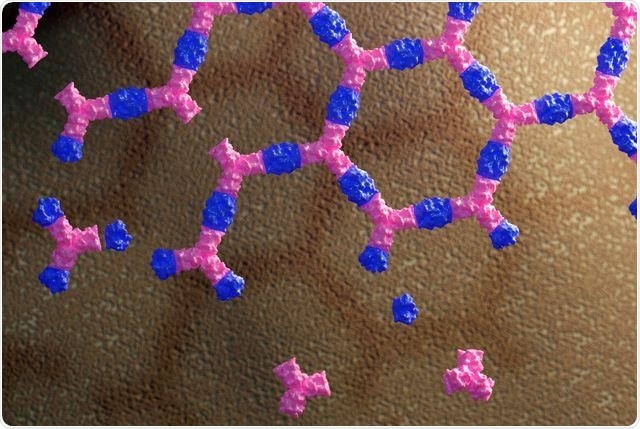A new study has revealed that a novel class of protein material that communicates with living cells without being absorbed by them can affect cell signaling. The protein material does this by attaching and sequestering cell surface receptors.

Illustration of a self-assembling protein array on the surface of a cell. Image Credit: Ian Haydon.
This finding could hold major implications for stem cell research and allow the development of novel materials engineered to modulate the behavior of living systems.
Published in the January 6th, 2021 edition of the Nature journal, the study is headed by the Baker laboratory at the University of Washington School of Medicine and the Derivery laboratory at the Medical Research Council Laboratory of Molecular Biology based in Cambridge, United Kingdom.
Cells communicate with their environment through receptors at their surface. Such receptors can attach to hormones, drugs, neurotransmitters, and toxins. When these molecules attach to a receptor, this activates some kind of reaction within the cell, a process called signaling.
However, in the case of the cell, this response should be fleeting, so that it is still responsive to the signal afterward. To attain this, cells will usually terminate signaling by absorbing an activated receptor as well as the molecule that activated it, targeting both for destruction within the cell.
This tendency of cells to internalize receptors likely lowers the efficiency of immunotherapies. Indeed, when antibody drugs bind their target receptors and then become internalized and degraded, more antibody must always be injected.”
Emmanuel Derivery, Assistant Professor, Medical Research Council Laboratory of Molecular Biology, University of Washington Health Sciences
To identify a way around this, Ariel Ben-Sasson, a postdoctoral scholar in Baker’s laboratory, engineered new proteins that organize into large, flat patches. This molecular scaffolding was subsequently designed to contain signaling molecules.
Joseph Watson, a graduate student of the Derivery lab, demonstrated that these protein materials could bind to cells, trigger surface receptors, and withstand from being absorbed by the cell for hours, or even days.
This work paves the way towards synthetic cell biology, where a new generation of multi-protein materials can be designed to control the complex behavior of cells.”
David Baker, Professor of Biochemistry and Director of UW Medicine Institute for Protein Design, University of Washington Health Sciences
The team swapped out the types of cell surface receptors that were targeted by the patch and demonstrated that different types of cells could be stimulated.
We now have a tool that can interact with any type of cells in a very specific way. This is what is exciting about protein engineering—it opens fields that people may not expect.”
Ariel Ben-Sasson, Postdoctoral Scholar, University of Washington Health Sciences
According to Hannele Ruohola-Baker, the co-author of the study and a professor of biochemistry and associate director of the UW Institute for Stem Cell and Regenerative Medicine, models of these novel materials could ultimately help doctors alleviate the risks of sepsis by regulating the inflammatory reaction to infections.
The new materials may even allow completely new ways to treat diabetes, COVID-19, and heart disease, and could reduce the downstream effects of strokes, such as Alzheimer’s disease.
“This breakthrough helps pave the way for the use of synthetic cell biology in regenerative medicine,” concluded Ruohola-Baker.
Source:
Journal reference:
Ben-Sasson, A. J., et al. (2021) Design of biologically active binary protein 2D materials. Nature. doi.org/10.1038/s41586-020-03120-8.